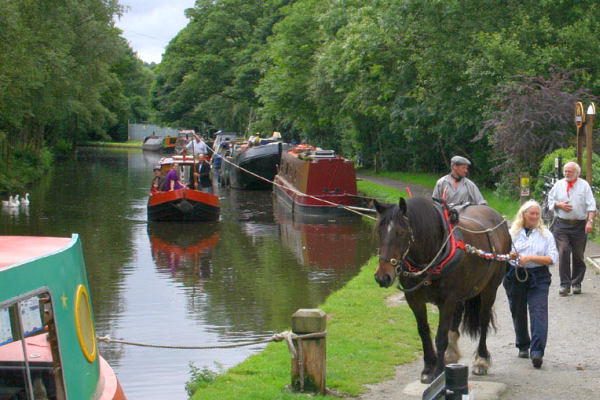Enjoy the unique experience of working your horse on the historic canal network of Britain. Please note there is no right to use horses on the inland waterways, but the Horse Boating Society is able to offer this opportunity through its campaigning work and representation with British Waterways.
The Horse Boating Society (HBS) would welcome horse handlers to contact the society, if they would like to receive training in horseboating, or if they think they might have a suitable horse to be trained for pulling craft on short or long journeys “to preserve and promote horseboating”.
The Horse Boating Society committee will be interested to speak to any horse owners and handlers wishing to learn the skills of horseboating. We invite interested people to come on our Familiarisation and Training Days, or to join in a journey to experience what is involved in horseboating.
 The Horse Boating Society does not own horses or boats. Its membership includes all 5 companies in Britain that operate horse-drawn craft for passengers on local set routes. The society undertakes short and long journeys on the national inland waterways network to promote educational and heritage work with the public. On these occasions a very few members can provide a horse trained for horseboating. The horse is worked by its owner or arranged driver. There is not an expectation that all society members will be allowed to drive the horse. Boats are provided for use by the society from individuals, companies, or societies wishing to support horseboating. Sometimes the owners will make up much of the crew for the horseboating. Insurance of the horse or boat remains with the owner.
The Horse Boating Society does not own horses or boats. Its membership includes all 5 companies in Britain that operate horse-drawn craft for passengers on local set routes. The society undertakes short and long journeys on the national inland waterways network to promote educational and heritage work with the public. On these occasions a very few members can provide a horse trained for horseboating. The horse is worked by its owner or arranged driver. There is not an expectation that all society members will be allowed to drive the horse. Boats are provided for use by the society from individuals, companies, or societies wishing to support horseboating. Sometimes the owners will make up much of the crew for the horseboating. Insurance of the horse or boat remains with the owner.
Operating with a horse and boat safely and responsibly on the waterways network requires specific skills to be learnt by horse and driver and crew. Generally speaking, there is a need for a crew size of a minimum of four. Most society members gain experience by acting as volunteer crew on HBS journeys.
When working on a known set route, it might be possible to use a boathorse of any size. For example, the Godalming Packet Boat Company on its usual trip with passengers does not need the horse to go under any bridges or through tunnels. Therefore the tallest, broadest horse could be used!
However on the national network, there are many very low bridges and some tunnels to negotiate, as well as narrow gaps created by railings or motorbike barriers and gates. As a result, the HBS finds that the preferred size of horse for horseboating nowadays is between 15hh-15.2hh. Some canals were built to accommodate larger horses, especially on broad canals with barges carrying heavy loads. Even these horses were usually no larger than 16.2hh. The problem now is that bridges built in the last 50 years have not taken horse passage into consideration and may be low. Also subsidence has lowered some bridges, whilst resurfacing of towing paths also reduces headroom in bridge-holes. The aesthetically pleasing curved bridge-holes of some canals cause a tall horse to walk very close to the water’s edge, and can cause the horse to fall in the canal. This is a situation that the society wishes to avoid.
The type of horse we usually seek would be 15-15.2hh, maximum 16.2hh, 6 years or over, with a quiet temperament. The horse must be able to work in close proximity with the public, because walkers, joggers, and cyclists pass by on sometimes narrow towing paths. Towns and country will be passed through. Safety in road traffic is desirable as there is sometimes no towing path. The society travels to waterways events and engages with the public with boathorse harnessing (and horseboating) demonstrations. On such occasions the horse might be amongst large crowds and other activities.
The horse handler usually provides horse transport to and from the boat, sometimes each day on a journey. The handler provides his or her own horse equipment such as grooming, feeding, watering utensils, and portable (electric) fencing. Help with boat harness might be possible. Distances travelled vary greatly, from 1-10 miles per day, which the driver walks with the horse, with breaks for meals. Basic accommodation on the boat can often be arranged.
All enquiries to Sue Day, HBS chairperson
07711 121 056 or 01457 834863 or
![]()
